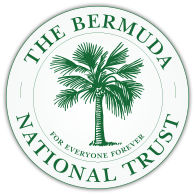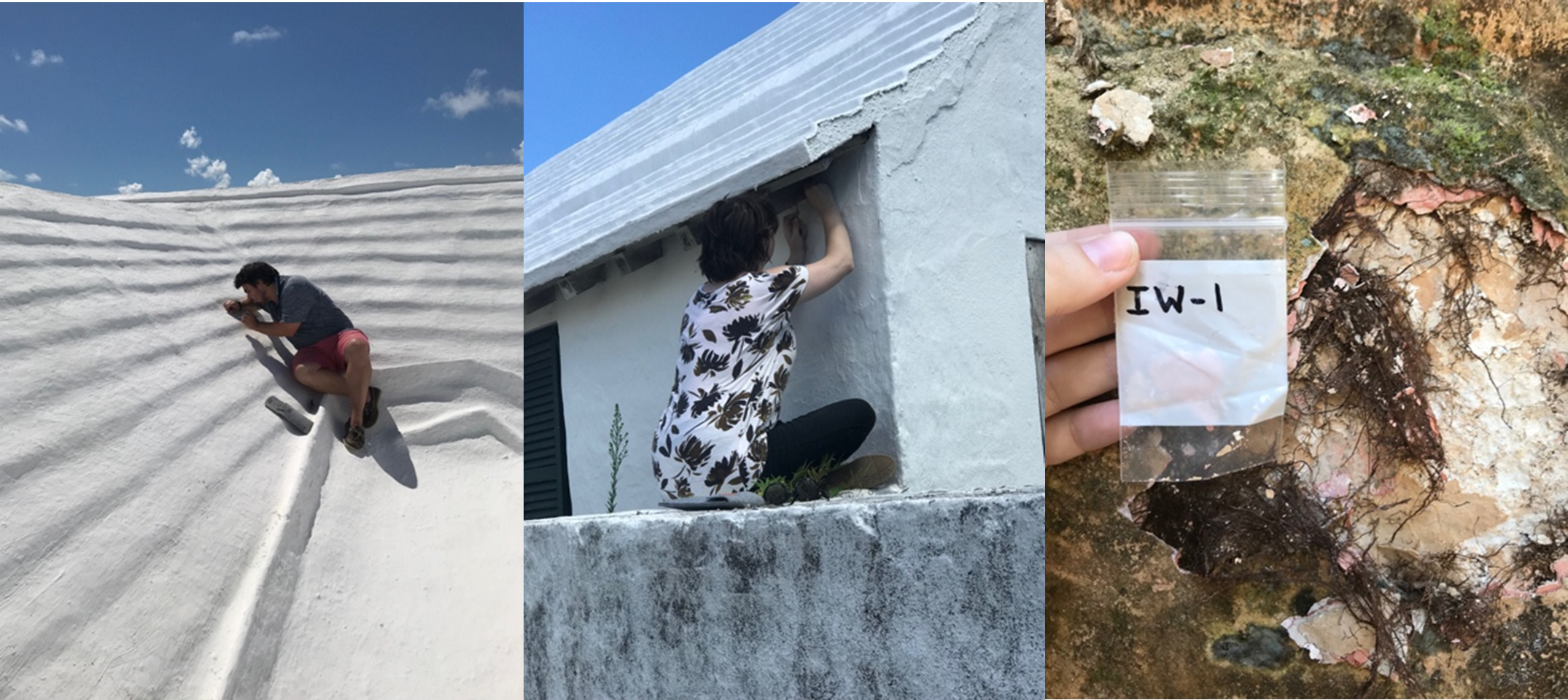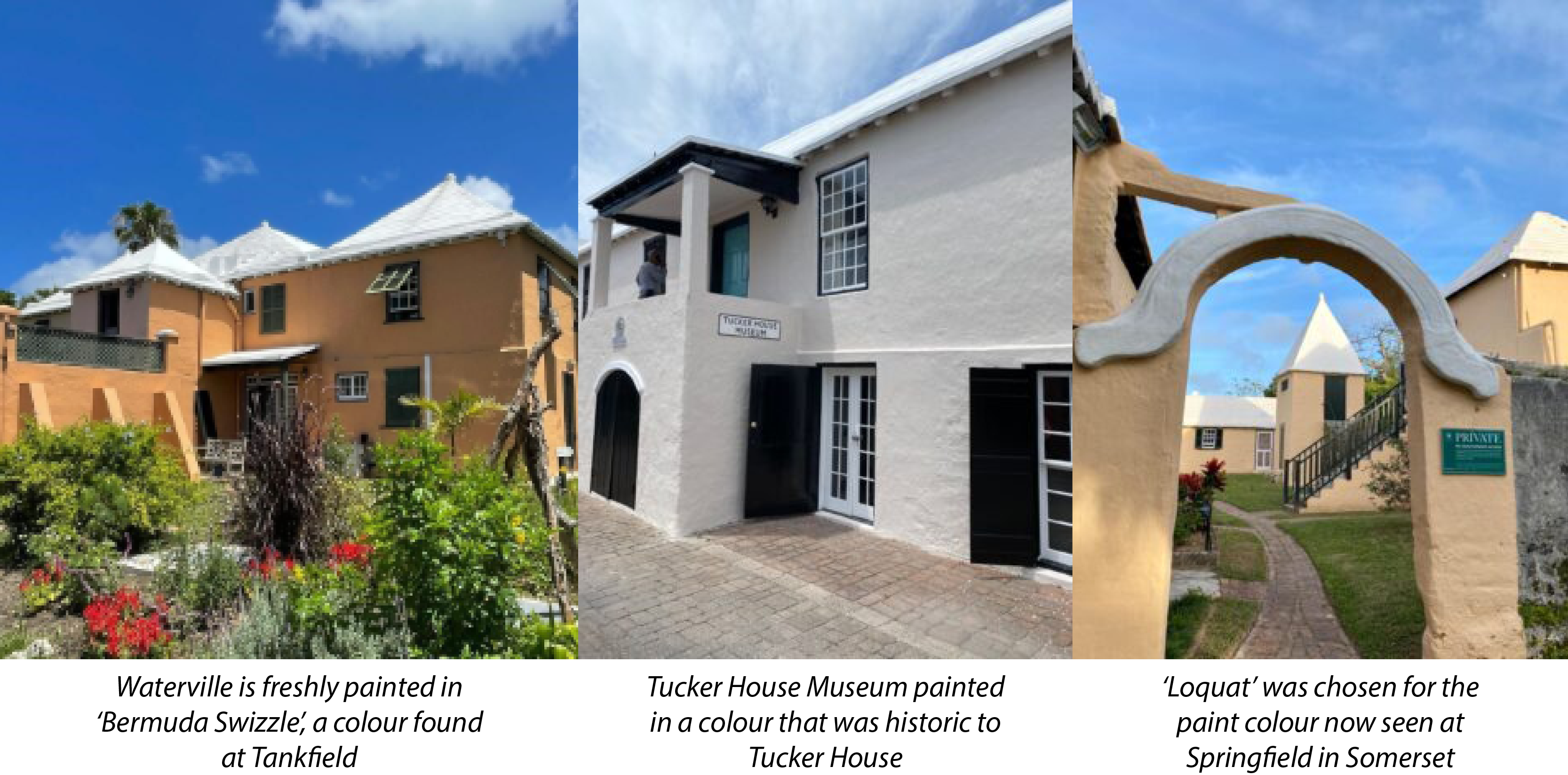The native or vernacular architecture of a country springs from the unique combination of local materials, climate, geological conditions and socioeconomics of a community. In Bermuda, soft limestone, local cedar, hurricanes and the lack of fresh ground water created the main elements of traditional Bermudian architecture.
Bermuda Architecture
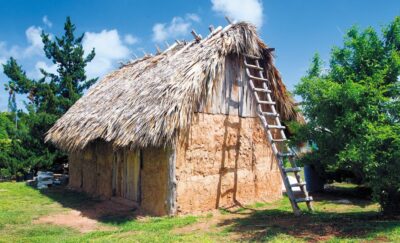 The priority for the first settlers in Bermuda was shelter and the easiest materials to access were cedar wood and palmetto leaves. Thus most houses constructed during the first part of the 17th century were of wood. A wooden framework anchored into postholes would be erected and the spaces between or outside the wooden frame probably filled with cedar lathes and then plastered with a limestone mixture. No buildings finished in this manner survive so it is impossible to be certain how they were built. Roofing was mostly of palmetto leaves. In 1687 Governor Robinson reported that of 579 houses in Bermuda 29 had stone roofs, 63 had wood shingles and the rest were thatched. The few buildings known to have been constructed in stone were forts and, according to John Smith’s 1624 engraving, the State House in St. George’s.
The priority for the first settlers in Bermuda was shelter and the easiest materials to access were cedar wood and palmetto leaves. Thus most houses constructed during the first part of the 17th century were of wood. A wooden framework anchored into postholes would be erected and the spaces between or outside the wooden frame probably filled with cedar lathes and then plastered with a limestone mixture. No buildings finished in this manner survive so it is impossible to be certain how they were built. Roofing was mostly of palmetto leaves. In 1687 Governor Robinson reported that of 579 houses in Bermuda 29 had stone roofs, 63 had wood shingles and the rest were thatched. The few buildings known to have been constructed in stone were forts and, according to John Smith’s 1624 engraving, the State House in St. George’s.
Towards the end of the century, the change to building in stone started to occur, partly due to the expansion of ship building leading to a shortage of cedar and partly because it was realised that stone buildings were more durable and more people had the means to build them. After 1693, land was only granted to settlers in St. George’s on condition that stone buildings were erected on the lots.
Image: Settlers’ Cottage at Carter House Museum
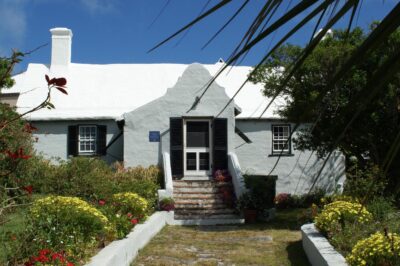
The change to building in stone was accelerated by two severe hurricanes in 1712 and 1715 which destroyed most of the island’s wooden churches and wreaked havoc among dwelling houses. In some cases the wooden walls of standing buildings were replaced by stone rather than by total rebuilding. An example of this was the Gardener’s Cottage in the grounds of the former Southampton Princess in Southampton where, because of the ruined state of the building by 2014, it was possible to see exactly where the timbers had been. That year the building was demolished piece by piece and is now stored at the National Museum of Bermuda where it is hoped it will be partly re-erected one day. Another example is Cavendish in Devonshire where we have a written account stating that the walls were replaced without removing the roof.
It was during this period that what is usually thought of as Bermuda’s vernacular architecture developed. Common features were gable roofs supported by substantial chimneys at the gable ends, straight or flared steps known as ‘welcoming arms’, windows just under the eaves, living quarters above cellar space very often built into a hillside away from fertile faming land or else on a sheltered shore, one-room-wide buildings with additions often made at right angles to the main wing. The Old Rectory, Fanny Fox’s Cottage and the Samaritans’ Cottages in St. George’s, all owned by the Trust, and Carter House in St. David’s are examples of this period. Separate outbuildings were butteries and small mostly one-room buildings used in many cases as kitchens or slave accommodation. No data has been found as to when ‘long-drop’ toilets became common.
There were also some much grander two-storey houses in the shape of a cross, described as cruciform, of which a few have survived. Palmetto House, owned by the Trust, is an example. Unique are the double-span Globe Hotel building in St. George’s and Verdmont in Smith’s Parish, both owned by the Trust.
As the century progressed, gable roofs tended to give way to hip roofs and buildings became more symmetrical as the Georgian style took hold. These homes were prominently sited proclaiming the owners’ status. The symmetrical facades had pilasters or quoins on the corners and occasionally around the centrally placed door, and there tended to be more space between the tops of the windows and the eaves.
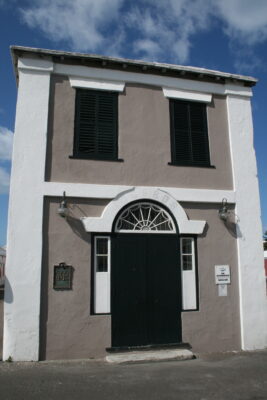
Many of the late 18th century features remained common and new features were shallower pitched roofs, wooden verandahs, keystones or architraves over doors and windows, fanlights over doors, more attention to symmetry and deeper spaces between windows and the eaves. Buildings became more likely to be more than one room wide, particularly in the towns. In the late 19th century there was a proliferation of ornamental non-functional chimneys and some functional ones were octagonal. Some roofs were covered by slates laid end to end instead of in the traditional over-lapping style. Windows were larger and panes sometimes only two over two instead of the traditional six over six or rare nine over six. Bay windows made their appearance and the ends of the rafter feet at the eaves were often covered with ornamental moulding. Moulding at the corners of buildings in general increased.
Rapid social change followed emancipation in 1834. Those freed from enslavement, or their descendants, many of whom were skilled builders, were gradually able to buy land and build houses. These were concentrated in areas such as North Village in Pembroke and Wellington in St. George’s.
Much building in the 19th century style continued, but after the First World War there began to be a revival in Bermuda cottage-style architecture, now thought of as Bermuda’s vernacular. Rupert Carlyle Hollis Hallett had built Juniper Hill in 1916/17 and in the 1920s and ‘30s rich Americans bought old houses and, mostly, restored them sensitively. John Humphreys published his iconic book Bermuda Houses in 1923 and boatbuilder turned housebuilder Nathaniel White Hutchings and his sons, architects and builders, were responsible for many renovations and new houses before and after World War II. Another shipbuilder turned architect was Edward Tucker, who was working in Bermuda from 1909. From 1928 until his untimely death in 1959, Wilfred Onions designed many houses, most notably a group in a fine sensitive traditional style on Trimingham Hill in the 1950s. Sadly most of his houses have not survived and his influence is felt in few of the buildings now being erected in Bermuda.
1612: Town of St. George began. First dwellings constructed
1612-1627: Nine churches constructed of wood, plaster and palmetto thatch
1620: State House in St. George’s, one of the first stone buildings constructed in Bermuda but in an English style
By 1620: Eleven forts built in Bermuda limestone for defence
c.1699: The Old Rectory in St. George’s
1700: Globe Hotel, St. George’s, built as residence for Governor Day
1712 & 1715: Severe hurricanes encourage Bermudians to build in local limestone
1716: Old Devonshire Church
1731: Mitchell House, now St. George’s Historical Society Museum: the stone house of a prosperous Bermudian family
c.1753: Tucker House in St. George’s
1796: Clermont, wealthy Bermudians building houses in the classical style: symmetrical, with high ceilings, fanlights, and quoins
Bay windows: Windows set in angular or curved projection from a house wall
Buttress: A stone support built against a wall at right angles to give it extra support
Eaves: The overhang of the edge of the roof
Eyebrow: A semicircular molded shape over the top of a window
Gable end: The generally triangular section of wall at the end of a pitched roof, occupying the space between the two slopes of the roof
Gabled roof: A roof with two sloping sides, forming a gable at one or both ends
Georgian style: A period roughly corresponding to the reigns of King George I – King George IV (1714-1830). In Bermuda the period approximately 1780-1830
Hipped roof: a roof with four sloping sides
Pilasters: a rectangular column with a top (capital) and base, projecting slightly from a wall as an ornamental motif
Quoins: an exterior angle of a wall and/or any of the stones used in forming such an angle, often being of large size and dressed or arranged so as to form a decorative contrast with the adjoining walls
Wallplate: a piece of timber set on top of a wall to support the weight of the roof
Historic Bermuda Paint Colours
Historic Bermuda Colours is a collaboration between the Bermuda National Trust and Texas A&M University’s Center for Heritage Conservation with the aim to use paint microscopy to establish a historic paint palette, comprising interior and exterior finishes.
Bermuda’s architecture is stand-alone in the world as is its widespread and renowned use of building colour. This dates to the 17th/18th centuries and is one of the most identifiable features of the local vernacular, along with the Bermuda roof.
In August 2018, Dr Brent Fortenberry of Texas A&M, paint conservationist Jane Ashburn, and the Bermuda National Trust’s Director of Preservation, Dorcas Roberts, took paint samples from various types and ages of buildings from the 18th and 19th centuries, and some that could even date from the 17th century. These included: Verdmont, Tucker House, Globe Museum, Bridge House, Norwood, Tankfield, Seven Gables, Inwood, Kirkdale Farm, Fanny Fox, Cluster Cottage and Reeve Court. The samples were analysed and matched to Sherwin Williams paints. This resulted in a remarkably attractive paint palette, very applicable to today’s tastes. Please see here the Bermuda National Trust Paint Colour Chart. The project was kindly sponsored by Pembroke Paint Company which is also the local supplier of the paints.
Waterville, Springfield and Tucker House have been painted in 2022 and 2023 using colours from this new colour chart. Waterville’s colour was named “Bermuda Swizzle” following a public search for the perfect name. Springfield’s colour was named “Loquat”.
While there are smaller comparable projects in the United States (see below), this is the first nationwide effort in the Greater Caribbean region to create a set of historic paint colors. Through this project historic house owners will have a set of accurate historic colors to choose from when deciding to paint their historic home. We hope that through a partnership with Sherwin Williams this project can be realised and made available to not just Bermudians but wider historic homeowners in the Greater Caribbean.
Comparable Projects
Understanding the Bermuda Roof Written and Illustrated by Sanders Frith-Brown for The Bermuda National Trust
The Traditional Building Guide Published by Department of Planning & The Bermuda National Trust
Alterations or Additions to Listed Buildings and/or Buildings Located Within Historic Areas Published by Department of Planning
